“Read My Lips”
Story by Alan Burnett, Michael Reaves
Teleplay by Joe R. Lansdale
Directed by Boyd Kirkland
Episode #064
Music Composed by Shirley Walker
Animation by Tokyo Movie Shinsha Co.
Original Airdate—May 10th, 1992
Plot: Batman discovers the mastermind behind a string of perfectly planned heists is a ventriloquism dummy, Scarface
The hardest part about writing about the Ventriloquist and Scarface is pronouns. Is he a “he,” or are they a “they”? Is it one man and his delusion, or two separate people voiced by the same mouth? As Alfred says, the Ventriloquist may be the weirdest Batman villain.

The Ventriloquist and Scarface are relatively recent additions to the Batman mythos, created in 1988 by Alan Grant, John Wagner, and Norm Breyfogle, but they feel like they are Golden Age rogues like the Joker, Two-Face, and the Penguin. They combine an absurd visual (a meek little man wielding a doll dressed like Al Capone) with an obvious leitmotif (puppetry, manipulation, and misdirection) that is fairly versatile in crime fiction.
The biggest difference between the comics version and the Batman: the Animated Series one is that comics Ventriloquist is a bad ventriloquist, unable to make Scarface pronounce his “B”s (which is a problem when you fight Batman), while animated Ventriloquist is an exceptional ventriloquist. Not only can he throw his voice into another room, his Scarface voice is so different from his normal one that no one, not even a computer analysis, can tell they’re the same person.
The easy way for animation to pull off that trick would have been for two different actors to play the part. Instead, George Dzundza plays both the terrifying Scarface, who sounds like a world-weary Edward G. Robinson, and the terrified Ventriloquist, who sounds like Piglet, extremely well. Which is incredible, because major scenes involve the Ventriloquist having emotionally heavy, abusive conversations with himself. I would have loved to have been in the recording booth for that day.
Another major difference between the comics and animated versions is that animated Ventriloquist completely lacks an origin. He doesn’t even have a name! There’s no explanation for how he got so good at ventriloquism, why his mind split in two, or how he, or his doll, know so much about the workings of Gotham that they can plan impeccable heists with precision that would make Clock King drool. All that matters for the character is that the Ventriloquist is a great ventriloquist, he does have a violent case of multiple personalities, and Scarface, and not the Ventriloquist, is a criminal mastermind.
One of the reasons Scarface and the Ventriloquist work so well as villains is the support of their crew. Unlike Maxie Zeus’s gang of naysayers and disbelievers, Scarface’s gang (short Ratso, medium Mugsy, and extra extra large Rhino) reinforce the Ventriloquist’s delusion that the puppet is the head of the gang. The key is Rhino, the Mountain-that-Wears-Pin-Stripes. Not only does he present the physical threat that neither the meek Ventriloquist nor the diminutive Scarface can provide, he’s absolutely convinced Scarface is a genius and the Ventriloquist is just hired help. And as long as this monster of a man believes it, everybody else better respect that distinction too. Earl Boen, the psychiatrist from the Terminator movies, beautifully acting against type here, is great as someone happy to be “too stupid to be a traitor.” But even Ratso, the new guy who knows the Ventriloquist is crazy, finds the jobs too lucrative to pass up, and so he goes along, feeding the Ventriloquist’s belief that Scarface is the boss.
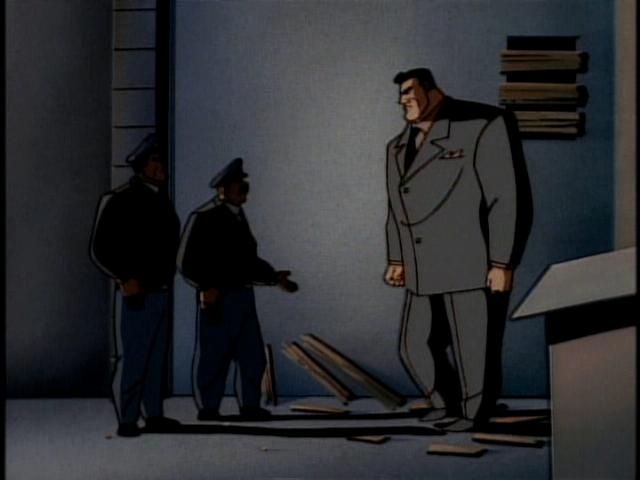
That’s another reason Scarface works as a villain: the suggestion that maybe the Ventriloquist isn’t crazy and that Scarface actually is a separate entity. Certainly after the Batmandroid, the idea of a living doll isn’t impossible in this universe. Boyd Kirkland always shoots Scarface as if he’s a person, the focus of attention, and a real threat, but he actually shows that Scarface can’t move without the Ventriloquist’s aid, and for all the threatening Scarface does with his tiny tommy gun, he never actually fires it, because it’s carved out of wood.
And yet, The Ventriloquist’s delusion is so all-inclusive, so convincing, that even Batman finds himself believing that maybe, just maybe, the doll really is alive. When Batman comes across the tiny doll sleeping in the giant bed, and accidentally knocks the doll’s eyes open, he jumps. It’s just a hint of the supernatural, but it’s enough to give the whole episode an eerie feel.
Otherwise, drawing on the self-stylings of Scarface, and the original movie, Scarface, the episode has a jazzy, noir crime movie style, which is great because the intersection of film noir and horror is exactly where Batman lives. Shirley Walker’s score homages composer Henry Mancini throughout the episode. We open on that staple of crime fiction, robbing a boxing match. Exposition is handled by spinning newspapers. Except for a reference to VHS and a “home theater enthusiast,” this episode could easily have taken place in 1939. (The video tape is necessary to identify Rhino by tattoo, though seriously, is that even necessary? How many crooks in Gotham are a head taller than Batman?)
Joe Landsdale’s script is one of the best in the series with lots of great details that reference the Scarface/Ventriloquist relationship: that the gang has set up shop in a mannequin warehouse; how Scarface “sleeps” in a fourpost canopy bed while the Ventriloquist sleeps on a dirty cot; how Commissioner Gordon and Scarface both worry about their blood pressure; and Batman using his own ventriloquist skills (learned from Zatanna) to take advantage of the Ventriloquist’s delusion and turn the puppet against the puppetmaster.
Especially good is Landsdale’s hardboiled dialogue, like the reminder that Batman doesn’t work for the cops and isn’t bound by things like laws. Scarface only referring to the Ventriloquist as “Dummy” is a joke from the comics, but Landsdale adds a lot of good lines of his own, like Scarface screaming at the Ventriloquist “Don’t put words in my mouth,” going on about “prima-notions,” or giving Batman the choice between being stabbed to death by a thousand mannequin hands or “Maybe you just get run over by a truck.”
The best line, however, is when Scarface reveals that he knows the Ventriloquist is a ventriloquist, which, boy, leads to some weird existential questions. Does Scarface also know he’s a block of wood? Does he know he’s a repressed part of the Ventriloquist’s psyche? He’s fine with having his men shoot the Ventriloquist. Is he willing to die, or does he think he’ll survive, somehow?
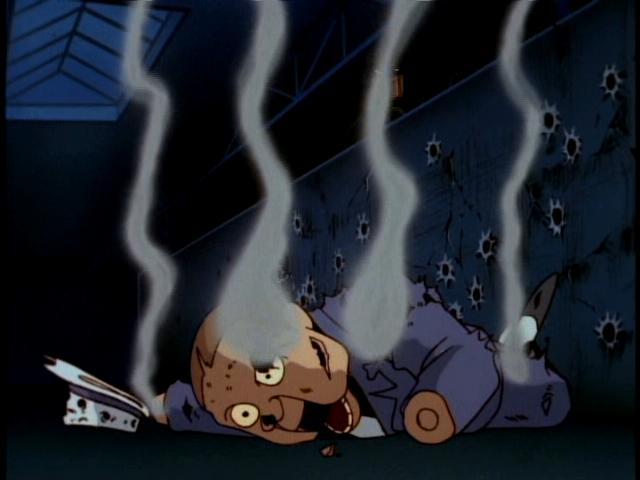
I mean, he will and he won’t. The BTAS writers quickly learned that, since Scarface really lives in the Ventriloquist’s head, the puppet can die horribly. After Batman dismembers Scarface with a batarang, Mugsy accidentally shoots Scarface in slow motion, causing the crime boss to dance in an homage to Sam Peckinpah, beautifully animated, as the whole episode is, by Tokyo Movie Shinsha. Mugsy looks so horrified by what he’s done, and the Ventriloquist is so heartbroken, that it takes a second to remember they are crying over splintered wood. This sets the precedent that every appearance of Scarface ends with the puppet being destroyed as violently as possible. After all, it’s even easier for Scarface to come back than for Ra’s al Ghul. The Ventriloquist just has to carve a new one and then stab that puppet in the face, a rebirth just as violent as his death.
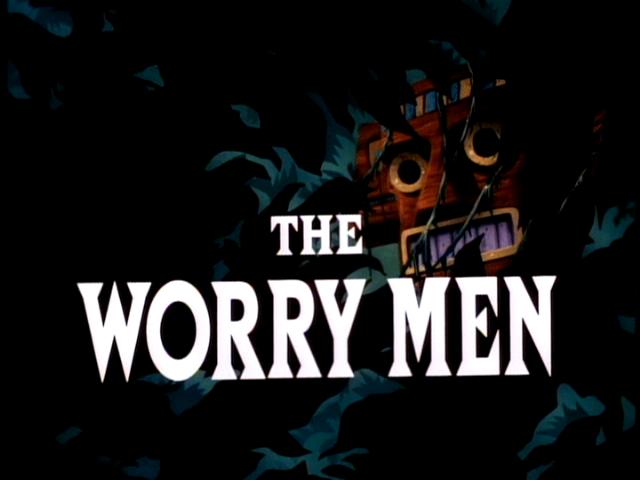
“The Worry Men”
Written by Paul Dini
Directed by Frank Paur
Episode #065
Music Composed by Lolita Ritmanis
Animation by Dong Yang Animation Co., LTD.
Original Airdate—September 16th, 1993
Plot: Mayan jaguar shamans brainwash Gotham’s elite, including Bruce Wayne, into handing over their fortunes. Does this crime wave have anything to do with the worry men Veronica Vreeland has brought back from Central America? Yes.
What do we call this storytelling trope where a racist caricature of a minority villain turns out to be a front for a white man behind the scenes? You know, the plot twist of Batman Begins and, like, every other season of 24. Sure, it looks like the villain is an “ancient Mayan witch doctor” stereotype straight out of a ‘30s pulp novel, but, ha ha, it’s actually the Mad Hatter exploiting the prejudices of his victims to rob them blind. It’s not Paul Dini and Frank Paur that are racist, it’s those that assumed the Mayans were the criminals, a.k.a., the audience.

I give Dini a lot of credit for addressing concepts of xenophobia and cultural appropriation in a 22 minute kids cartoon show. He shows that even the “benign” racism of Bruce Wayne’s upper class friends can be harmful. The rich use traditional Guatemalan worry dolls to help them sleep, an example of Americans solving their emotional problems by appropriating native traditions a dozen years before Eat, Pray, Love. And their prejudices rob both the victims of their racism and themselves of agency, in this case literally.
Importantly, Batman immediately suspects the “Mayan shaman” is not what he appears to be and never believes the worry dolls could cure his anxieties (even if Alfred hopes they might). Batman the detective does not allow prejudice to cloud his judgement, and Dini suggests we should follow Batman’s lead (well, to a certain degree).
In a nice touch, most of the “Mayans” are mind-controlled white criminals, and the only one who’s actually Central American, the unnamed “honest native craftsman,” is the most moral person in the show. He forgives the Mad Hatter, protects him from mob justice, and still drops a little ironic punishment on his captor in the form of a Batman worry doll.
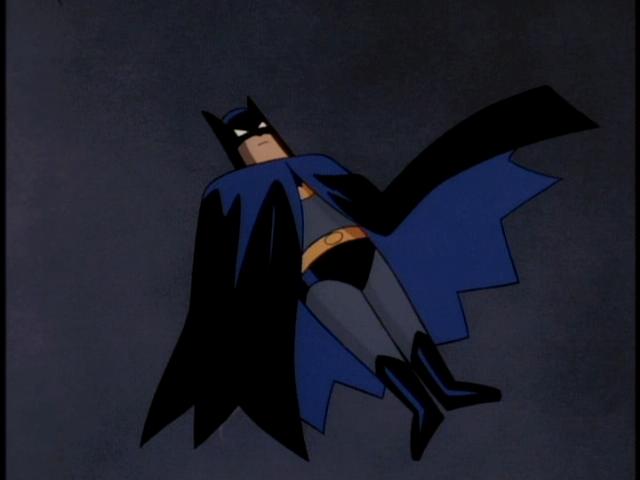
To further demonstrate the creators’ commitment to diversity, Dini introduces two persons of color to the cast, worry wart millionaire Hayden Sloane, played by LeVar Burton, and Bruce Wayne’s sassy secretary, Dana, played by Vernee Watson-Johnson. This display of inclusion would be more effective if either character were ever seen again.
Spoiler: they are not.
Unfortunately, the message might be too subtle for the medium. As much as it’s a ploy by the Mad Hatter, most of the thrills of the episode are still derived from Batman fighting a nearly naked dark reflection of himself who uses “native” versions of the bat-gadgets to cause mayhem on the rooftops of Gotham. In some ways, Dini and Paur are having their racist cake and eating it too, exploiting jungle doctor stereotypes for entertainment even while implying that that such exploitation is what crazy villains do.
Veronica Vreeland, for her part, shows some growth since “Birds of a Feather.” Sure, she’s saving the rainforest mostly as an excuse to throw a jungle themed party where she and her friends can dress up as 19th century explorers, but at least she’s trying to help her friends and make the world a better place. (Would Ra’s al Ghul approve? Here are the wealthy of Gotham doing the very thing he accused them of failing to do, gathering together to save the rainforest.) Additionally, she takes a swing at the “Mayans” attacking Batman, which means this is one heiress who isn’t getting kidnapped again without a fight.

Which brings us to the Mad Hatter. This is the second episode where people around Bruce act completely out of character, and the second act reveal is that Jervis Tetch is to blame. From now on, Tetch is clearly the go-to answer for otherwise inexplicable shenanigans.
The flaw in the Mad Hatter’s plan is that (like the Scarecrow) he’s too greedy and too impatient. One rich man embezzling from his company is self-explanatory, even likely. Twenty doing so in the same week is clearly the work of an outside manipulator, and the number of suspects capable of mind-control is exactly one. Which is to say I don’t know why the cops arrest Hayden Sloane when Sloane is clearly a victim. (It’s because Sloane’s black, isn’t it?)
The other problem is that after his unique and interesting mind-control scheme is revealed, the Mad Hatter goes into generic Batman villain mode, pitting Batman against a room full of deathtraps (in another warehouse full of mannequins) and on-theme costumed henchmen. He even tries to take Batman’s cowl (with Batman’s head still in it), something he eschewed doing in “Perchance to Dream.” Batman actually calls the Mad Hatter out on transitioning from a creepy, lust driven kidnapper to just another thief (something he didn’t do with Two-Face, Poison Ivy, or Scarecrow). Hatter’s excuse that “even small islands” are expensive is pretty great.
The mannequin versions of Batman’s enemies recall the nightmare from the end of “Dreams in Darkness,” only now there are even more rogues to play with, including the Mad Hatter himself, the Riddler, and a marionette Harley Quinn (that’s smashed by a Jack-in-the-Box Joker—SYMBOLISM!). “The Worry Men” is the last of the original 65 episodes produced, and marks the end of another period in Batman’s war on crime. Yes, the rogues gallery has expanded, but they’ve also gone on from being debilitating nightmares to become, well, scarecrows, dressed up mannequins that look scary but are actually easily defeated. Yes, Gotham has gotten weirder, but Batman has got it under control. No worries.
This break in production also means it’s a good space to take a break in reviewing the episodes. So join us next week, as we shift gears and review the DC Animated Universe’s only major theatrical release, Batman: Mask of the Phantasm.
Steven Padnick is a freelance writer and editor. By day. You can find more of his writing and funny pictures at padnick.tumblr.com.










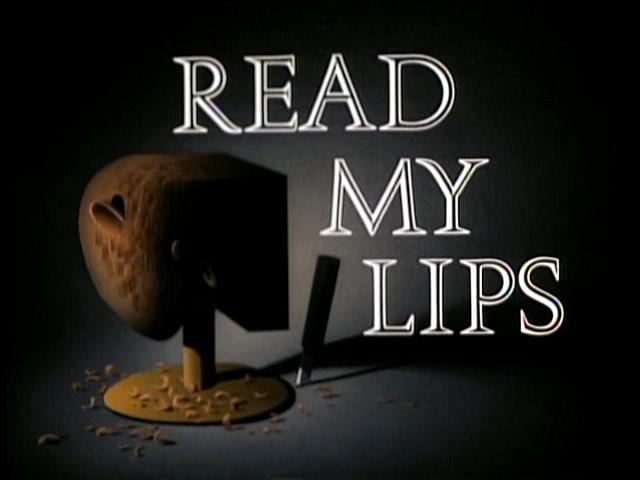
I don’t think there’s much similarity between Scarface’s voice and Edward G. Robinson’s. Robinson’s voice was more nasal, not as gravelly, and with a different type of New York accent. Dzundza’s Scarface voice reminds me more of someone like Lee J. Cobb or Vic Tayback.
I think at this point I’m running out of ways to say the animation and music were great, so there’s not much more to add. Except that I keep getting this Rhino mixed up with the one from the contemporary Spider-Man cartoon and thinking that Earl Boen played that character instead (that Rhino was actually Don Stark). Boen would eventually play the Red Skull on that show, though.
Not much to say about “The Worry Men,” except that I liked the way it fleshed out Veronica Vreeland and made her a more sympathetic character. It was nice when the show fleshed out Bruce Wayne’s life as well as Batman’s, and once Ronnie grew out of her self-absorption somewhat, she turned out to be a worthy friend for Bruce.
“Read My Lips” has one of my favorite lines in the whole series, when Batman says “You’re breaking my heart, Rhino.” It is deliciously out of character and in character at the same time.
Read My Lips adds a new level of weirdness to Batman’s villians. Everyone knows its crazy but Scarface is getting the job done.
George Dzundza does a great job as both characters.I didn’t think it was weird when Batman jumped when he saw Scarface ventriloquist dummies are scary. TheWorry Dolls is sort of meh, but doesn’t it have Roddy McDowell playing the Hatter again? I always smile when I hear his voice.
@3: Right, McDowall played the Hatter throughout B:TAS and The New Batman/Superman Adventures. He passed away before Justice League, but they retired the character rather than recasting him.
“Which is to say I don’t know why the cops arrest Hayden Sloane when Sloane is clearly a victim. (It’s because Sloane’s black, isn’t it?)”
Is it not because he stole from customers, rather than his own company? IIRC, he was an investment manager with other people’s money, directly.